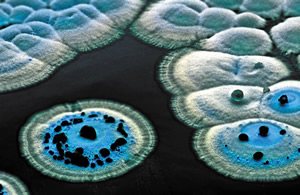Re: Microbe Mission B/C
Posted: February 22nd, 2018, 5:30 pm
(I assume no one is going to answer Alex's question)

What is the name of the organism shown above?

What is the name of the organism shown above?

Mitochondria stain gram-negative/gram-intermediate and are thought to be evolved from G- bacteria (Rickettsia); porins are found only on the G- outer membrane (inner membrane has different proteins like PTS and ABC) while cardiolipins are found only in the inner cytoplasmic membrane. A quick PubMed search tells me that cardiolipin domains may be involved in bacterial cell division? IDK how you would explain why each is found where other than pointing to evolution.Alex-RCHS wrote:Here’s a question that I’ve been trying to figure out lately:
The presence of cardiolipins and porins are separately cited as evidence of endosymbiosis. Why are cardiolipins found on the inner mitochondrial membrane, but porins on the outer mitochondrial membrane, if both are also found in bacterial cell membranes?
I must admit I don’t know the answer but I hope that someone does.
Volvox.Tailsfan101 wrote:(I assume no one is going to answer Alex's question)
What is the name of the organism shown above?
Correct, your turn.allopathie wrote:Volvox.Tailsfan101 wrote:(I assume no one is going to answer Alex's question)
What is the name of the organism shown above?
Hmmm, when I posted that question I thought that BOTH cardiolipins and porins were found on the bacterial cytoplasmic membrane (which would make it weird that the former are found in the outer mitochondrial membrane and the latter on the inner — the focus of my question) but actually what you posted is correct. My bad.allopathie wrote: Mitochondria stain gram-negative/gram-intermediate and are thought to be evolved from G- bacteria (Rickettsia); porins are found only on the G- outer membrane (inner membrane has different proteins like PTS and ABC) while cardiolipins are found only in the inner cytoplasmic membrane. A quick PubMed search tells me that cardiolipin domains may be involved in bacterial cell division? IDK how you would explain why each is found where other than pointing to evolution.
I didn’t think anyone would actually test on this lol. I believe it’s SSSS and it’s caused by staphylococcus, or in the case of our list MRSA. It produces an exotoxin that causes these symptoms.allopathie wrote:Patient: 6 month old boy
Symptoms: poor feeding, irratibility, diffuse skin erythema, epidermis coming off easily with gentle pressure
Diagnose the condition (species + any relevant information) and identify the cause (antigen? cell lysis? endo/exotoxin?) of the symptoms.
Are you B division? Because MIT/SOUP diagnoses were pretty hard. Diffuse skin erythema is characteristic of SSSS, but make sure you don't confuse it with toxic shock syndrome or TS-like syndrome (caused by S. pyogenes).The48thYoshi wrote:I didn’t think anyone would actually test on this lol. I believe it’s SSSS and it’s caused by staphylococcus, or in the case of our list MRSA. It produces an exotoxin that causes these symptoms.allopathie wrote:Patient: 6 month old boy
Symptoms: poor feeding, irratibility, diffuse skin erythema, epidermis coming off easily with gentle pressure
Diagnose the condition (species + any relevant information) and identify the cause (antigen? cell lysis? endo/exotoxin?) of the symptoms.
Hopefully I’m not entirely wrong
Yea I’m div B. Usually the tests are not to the level of detail to test things like thisallopathie wrote:Are you B division? Because MIT/SOUP diagnoses were pretty hard. Diffuse skin erythema is characteristic of SSSS, but make sure you don't confuse it with toxic shock syndrome or TS-like syndrome (caused by S. pyogenes).The48thYoshi wrote:I didn’t think anyone would actually test on this lol. I believe it’s SSSS and it’s caused by staphylococcus, or in the case of our list MRSA. It produces an exotoxin that causes these symptoms.allopathie wrote:Patient: 6 month old boy
Symptoms: poor feeding, irratibility, diffuse skin erythema, epidermis coming off easily with gentle pressure
Diagnose the condition (species + any relevant information) and identify the cause (antigen? cell lysis? endo/exotoxin?) of the symptoms.
Hopefully I’m not entirely wrong

1. BacteriaThe48thYoshi wrote:I guess I’ll just post a question
1. What domain is this organism from
2. What is this specific individuals effect on human life
3. What is significant about its structure/appearance
Edit: Sorry for double post